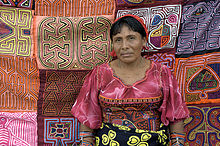Mola (sewing artwork)

The Mola (. Pl Molakana or Molas ) is a traditional Nähkunstwerk the Kuna - Indians . It is a hand-sewn rectangular motif picture. It reflects the mixture of traditional Kuna culture with influences from the modern world.
The art of mola sewing emerged in the middle of the 19th century with the availability of inexpensive colorful cotton fabrics , the fabrics are plain weave and the sewing material is derived from the body painting . The design of today's Molas is often based on modern graphics, pictures from books, cartoons or political posters, but also influenced by traditional motifs from the Kuna legends and their culture.
The molas are sewn on the front and back of the Kuna women's blouses . They consist of scraps of fabric that are sewn together in two to seven layers and create a motif by removing and sewing individual surfaces.
The quality of the molas is characterized, among other things, by the number of layers of fabric used, the fineness of the sewing stitches and the evenness and size of the cut-out parts of the picture.
literature
- Kit S. Kapp (Author), Black & White Illustrations (Illustrator): Mola Art from the San Blas Islands . KS Kapp Publications, 1972.
- Maria Seidl: Ge / layers in the course of time. The Molasammlung of the Museum für Völkerkunde Wien (diploma thesis). Ed .: University of Vienna. 2009.
